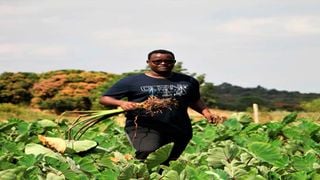
Gregory Kiamba on his arrow roots farm in Kilala, Makueni County.
| Pius MaunduSeeds of Gold
Premium
Gregory Kiamba: My 15,000 arrowroots side hustle
Situated on Machakos-Wote Road, Kilala township is a busy trading centre with mangoes and oranges dominating farm produce sold at the main market.
The fruits come from tens of orchards in the neighbourhood, making the area a top fruit-belt in the country.
For farmer Gregory Kiamba, however, fruits are not his crop of choice. He has gone against the grain – swimming upstream literally.
Kiamba, a fourth-year pharmacy student at Jomo Kenyatta University of Agriculture and Technology (Jkuat), grows arrowroots in the semi-arid region.
Seeds of Gold team finds him supervising workers weeding his one-acre farm.
“I grow 15,000 arrowroots and harvest from at least 13,000 of them at any one time,” the 25-year-old says, adding the area was once a neglected wetland.
There are two varieties of arrowroots in the Kenyan market – Eddoe and Dasheen. Eddoe is the indigenous variety which thrives in marshlands and takes eight months to mature.
Dasheen is a hybrid with roots in Rwanda. It does well in dry lands and takes six months to mature. Kiamba grows Eddoe since his farm is a marshland.
“We bought the first seedlings at Sh5 from a farmer in the neighbourhood. We have since been producing our own seedlings from the suckers and the tips of the tubers we harvest. To prevent the stolons (the top part of an arrowroot plant between the leaves and the tuber) from withering, we lump them in a soggy pit on the farm until the planting season,” he says.
Grow arrowroots
To grow arrowroots, he starts with tilling the farm to remove weeds and grasses. He then digs planting holes that are at least 15cm deep and introduces the stolons. Agronomists recommend a spacing of 30cm between plants and rows.
“Arrowroots do not require synthetic fertilisers since they affect their taste. They need farmyard manure and thrive in well-drained soils. If the plot is too wet, one should install cut lines to drain the wetland. The size of the arrowroots tubers depends on agronomic practices, manuring, mulching, and moisture of the plot. They should be harvested when the soil is moist to avoid destruction of the tubers,” says George Kamami, an agronomist in Makueni County.
Kiamba, the last born in a family of five, says his biggest source of inspiration has been his father, Mr Francis Mutua, a prominent fruit farmer in the region.
But it is his grandfather, Mr John Kiamba (now deceased), who planted the agribusiness dream in him. The old man bequeathed the grandson the piece of land on which he grows arrowroots as a way of thanking him for his affection and friendship.
“I turned to arrowroots in 2018 after years of growing maize on this plot. Since the crops would have died if planted earlier, we used to plant at the height of the dry spell only to end up fighting ravenous birds which descended on the maturing crop in their thousands as they had no other farms to feed from at that time,” he recalls.
“After the first arrowroots harvest, we realised in hindsight that we had been dealing with the wrong value chain,” he adds.
As a student, dealing in arrowroots is less stressful for Kiamba compared to other crops.
“Since we neither water nor apply fertilisers and pesticides on the arrowroots, maintaining the enterprise is easy. The only thing we do on the plot is weeding and thinning. Weeding is done once every two weeks. This gives me time to focus on my studies and market the tubers,” says Kiamba, who travels home twice a month to check on the farm.
Arrowroots are harvested by uprooting. Before they are uprooted one drives a machete around the tuber to cut off the roots.
“The soil should be moist to prevent breakage of the root tubers while uprooting,” he says.
Theirs has been a farming family, with their parents relying on agribusiness to pay their school fees and afford them a good lifestyle.
Big delicacy
Kiamba was thus expected to inherit his father’s sprawling orchard that hosts oranges, pixie and mango trees. However, an insatiable demand for arrowroots in a region where most farmers grow fruits pushed him to the crop.
Although arrowroots are a hard find in the largely arid region, they are a big delicacy. They are mainly boiled for breakfast in most Kenyan communities.
One can also make special porridge from them by boiling and blending them with cassava and coconuts. Kiamba markets his harvest through word of mouth and online.
Some traders at Kilala trading centre book them when the crop is still on the farm.
“We sell three pieces at Sh100, making at least Sh300,000 from the entire crop per harvest. I comfortably pay my college fees from the crop,” he says.
The government has been proactively pushing young people to embrace agribusiness.
Agriculture PS Hamadi Boga says the average age of the Kenyan farmer is 59 , something which has got the government and development experts concerned as it portends food insecurity and joblessness among the youth.
So, does Kiamba intend to continue farming even when he is done with his pharmacy studies.
“Upon graduation, I will continue farming because I have a goal of changing how young people view agribusiness,” he said.





